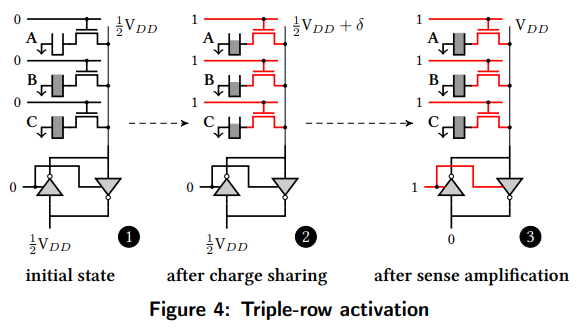Ambit: In-Memory Accelerator for Bulk Bitwise Operations Using Commodity DRAM Technology

Many important applications trigger bulk bitwise operations, i.e., bitwise operations on large bit vectors. In fact, recent works design techniques that exploit fast bulk bitwise operations to accelerate databases (bitmap indices, BitWeaving) and web search (BitFunnel). Unfortunately, in existing architectures, the throughput of bulk bitwise operations is limited by the memory bandwidth available to the processing unit (e.g., CPU, GPU, FPGA, processing-in-memory).To overcome this bottleneck, we propose Ambit, an Accelerator-in-Memory for bulk bitwise operations. Unlike prior works, Ambit exploits the analog operation of DRAM technology to perform bitwise operations completely inside DRAM, thereby exploiting the full internal DRAM bandwidth. Ambit consists of two components. First, simultaneous activation of three DRAM rows that share the same set of sense amplifiers enables the system to perform bitwise AND and OR operations. Second, with modest changes to the sense amplifier, the system can use the inverters present inside the sense amplifier to perform bitwise NOT operations. With these two components, Ambit can perform any bulk bitwise operation efficiently inside DRAM. Ambit largely exploits existing DRAM structure, and hence incurs low cost on top of commodity DRAM designs (1% of DRAM chip area). Importantly, Ambit uses the modern DRAM interface without any changes, and therefore it can be directly plugged onto the memory bus. Our extensive circuit simulations show that Ambit works as expected even in the presence of significant process variation. Averaged across seven bulk bitwise operations, Ambit improves performance by 32X and reduces energy consumption by 35X compared to state-of-the-art systems. When integrated with Hybrid Memory Cube (HMC), a 3D-stacked DRAM with a logic layer, Ambit improves performance of bulk bitwise operations by 9.7X compared to processing in the logic layer of the HMC. Ambit improves the performance of three real-world data-intensive applications, 1) database bitmap indices, 2) BitWeaving, a technique to accelerate database scans, and 3) bit-vector-based implementation of sets, by 3X-7X compared to a state-of-the-art baseline using SIMD optimizations. We describe four other applications that can benefit from Ambit, including a recent technique proposed to speed up web search. We believe that large performance and energy improvements provided by Ambit can enable other applications to use bulk bitwise operations.
Publication Date
Published in
Research Area
External Links
Uploaded Files
Copyright
This material is posted here with permission of the IEEE. Internal or personal use of this material is permitted. However, permission to reprint/republish this material for advertising or promotional purposes or for creating new collective works for resale or redistribution must be obtained from the IEEE by writing to pubs-permissions@ieee.org.
